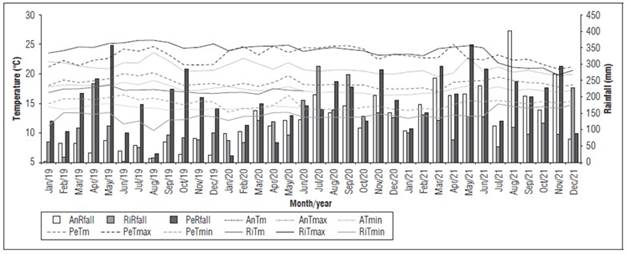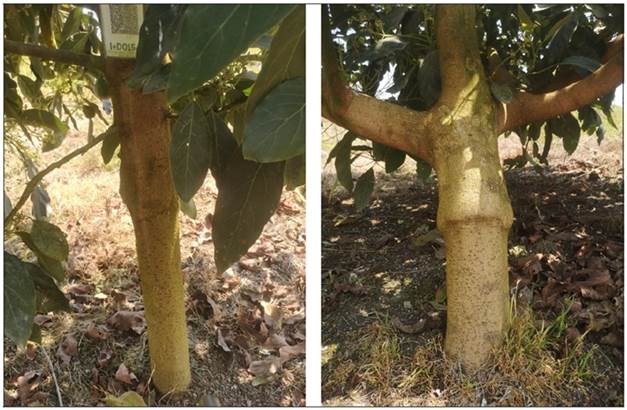INTRODUCTION
Fruit quality is influenced by weight, health, and nutritional characteristics, which must be optimal when marketed (García-Martínez et al., 2021). Worldwide, avocado (Persea americana Mill.) cv. Hass has presented an increase in acreage. Colombia in 2020 ranked second in harvested area (78,578 ha), contributing 9.7% of the established world area, and the second place in production with 876,754 t (10.9%), only surpassed by Mexico, which contributed 29.7% of world production (FAO, 2022). Nonetheless, the increase achieved in the last decade in avocado production cv. Hass in the country, mean yield (11.15 t year-1) (FAO, 2022) represents only 34.3% of the Hass productive potential (32.5 t year-1) under optimal environmental conditions and good agricultural practices (Gazit and Ish-Am, 2007). Main producing areas are located in the central and western mountains in the Andean region, in high cold climate regions situated at altitudes between 1,800 and 2,400 m a.s.l., especially in departments of Antioquia, Caldas, Risaralda, Pereira, Tolima, and Valle del Cauca (Agronet, 2022).
Grafting is the main technique used to obtain plantlets with genetic identity to establish uniform commercial fruit orchards. Therefore, evaluating proper/compatible rootstock in perennial fruit plants is highly significant because once an orchard is established, it remains productive for a long time (Nawaz et al., 2016). The resulting interaction between the rootstock and the scion must have optimal characteristics that generate a lasting union that allows adequate development of the new individual (Nawaz et al., 2016). Despite the importance of using a suitable rootstock, outstanding rootstocks in fruit trees have not been widely evaluated in Colombia. Notwithstanding the comparative advantages they present, such as favoring fruits' postharvest quality (size, juice content, percentage of soluble solids content) (Yeşiloğlu et al., 2014; Yilmaz et al., 2014; Raddatz-Mota et al., 2019), affects plant size and yield (Berdeja-Arbeu et al., 2016), and improvements in sanitary quality (Rivero et al., 2003), increased water and nutrient absorption (Nawaz et al., 2016) and the tolerance and resistance to abiotic and biotic stresses (Lazare et al., 2020).
As part of the grafting process, there must be successful compatibility in the union between the two tissues (rootstock/scion) and scion-rootstock incompatibility limits grafting techniques success (Loupit and Cookson, 2020). This is due to some factors, including insufficient genetic proximity, physiological or biochemical causes, lignification at the graft union, poor graft architecture, insufficient cell recognition between the union tissues, and metabolic differences in the stem and rootstock (Habibi et al., 2022). It is highlighted that the incompatibility is characterized mainly due to tissues anatomical differences generating impairments to the translocation of water and nutrients and low tree development resulting in tissue union and regeneration problems and failure in the union (rootstock/graft) (Baron et al., 2019).
The evidence of compatibility between rootstock and scion is defined, among other things, by excessive callus development, evidenced by great difference between the diameters of the rootstock and scion stem (Davies et al., 2018). The rootstock affects the behavior of the grafted aerial part (Salazar-García et al., 2011). The results of the rootstock can go further, influencing some scion properties, such as fruit quality and yield (Giorgi et al., 2005; Gullo et al., 2014; Balducci et al., 2019), tolerance to cold and pests, and resistance to pathogens (Rubio et al., 2008; Goldschmidt, 2014). On the other hand, the incompatibility limits the formation of the rootstock/scion union (Okimura et al., 1986). Different studies on fruit species have shown that grafted plants with incompatibility symptoms affects the capacity to absorb nutrients and water (Lazare et al., 2020; Tamayo-Vélez et al., 2022), present less robust and efficient root systems, and reduce fruit yields and quality (Tedesco et al., 2022).
When establishing commercial orchards, graft compatibility/incompatibility information is essential for grafted fruit trees. There are many conflicting reports on changes in fruit quality resulting from grafting. The differences in reported results may be attributable to different production environments, the type of rootstock/scion combination used, and the harvest season (Davies et al., 2018). The present study evaluated the effect of morphological alterations of the stem, defined as compatibilities and incompatibilities between the rootstock and graft, on avocado cv. Hass fruit yield and quality in three producing areas in Colombia, on two consecutive years.
MATERIALS AND METHODS
Location
Evaluation was carried out during 2020 and 2021 years in three commercial avocado orchards cv. Hass. First one in Rionegro (Antioquia) at 2,175 meters above sea level (m a.s.l.), the second in El Peñol (Antioquia) at 2,198 m a.s.l., and the third orchard in Anserma (Caldas) at 2,000 m a.s.l. Avocado orchards were established by seedlings obtained by grafting Hass scions upon creole rootstock seedlings. Avocado grafted plants were propagated with tip grafting, with a scion bud of cv. Hass (standard procedure). The scion origin was unknown but was assumed to be a commercial clone with uniform characteristics. Orchards were established in 2013 and are registered for the international fruit market. Soils of the experimental areas are representative of the region, being classified as an Andosol according to FAO World Reference Base classification (Delmelle et al., 2015; Santos et al., 2018).
According to Belda et al. (2014), the region's climate is Cw subtropical dry-winter, according to Köppen's classification. Climatic variables were recorded in each location (Fig. 1) by using a WatchdogTM 2000 portable weather station (Spectrum Technologies, 3600 Thayer Court, 107 Aurora, IL 60504). Average, maximum and minimum temperatures in Rionegro were 17.2 °C, 23.8 °C, and 13.0 °C, with an annual rainfall of 1,800 mm. In El Peñol, these were 18.5°C, 23.0°C and 14.9°C, with an accumulated annual rainfall of 1.921 mm. Finally, in Anserma were 17.4 °C, 21.0 °C, and 14.8 °C, with an annual rainfall of 1.770 mm.
Experimental design
A split-plot design with a blocking factor per location (Anserma, El Peñol, and Rionegro) (random effects) was used. The main plot corresponded to the harvest season factor (Hs) (fixed effects), and the subplots to the compatibility factor (C) (fixed effects). Harvest factor (main plot) corresponded to the four harvest seasons between 2020 and 2021, where two main harvests (2020M and 2021M) and two secondary or 'Mitaca' harvest seasons (2020SM and 2021SM) were considered. This way, main harvest corresponded to the fruit harvested between December and January, while the secondary harvest corresponded to the fruit harvested between July and August of each productive year. Compatibility factor (subplot) was defined by two treatments (compatible and incompatible), derived from the ratio between the rootstock stem diameter (RD) and the scion stem diameter (SD), measured at 5 cm below and above the graft scar. A compatible tree was considered when RD/SD was equal to 1 ± 0.05, and an incompatible tree when RD/SD was less than 0.95 (Fig. 2).
Experimental unit
In each location, 15 compatibles and 15 incompatible trees were selected. Yield (kg fruit/tree) and number of fruits per tree were recorded for each treatment. In the same way, weight and size of each harvested fruit were individually characterized, as established by FAO in the CODEX STAN 197-1995 Revision (Tab. 1), for export sizes (CCA, 2011).
Table 1 Fruit quality of avocado cv. Hass is characterized by weight and size for export according to CODEX STAN 197-1995 (CCA, 2011).
| Caliber | Fruit weight (g) | Caliber | Fruit weight (g) | ||
|---|---|---|---|---|---|
| Minimum | Maximum | Minimum | Maximum | ||
| Discard | 0 | 80 | 24 | 170.1 | 181 |
| Industrial | 80.1 | 94 | 22 | 181.1 | 200 |
| 32 | 94.1 | 135 | 20 | 200.1 | 217 |
| 30 | 135.1 | 149 | 18 | 217.1 | 249 |
| 28 | 149.1 | 160 | 16 | 249.1 | 284 |
| 26 | 160.1 | 170 | 14 | 284.1 | 600 |
Statistical analysis
Two analyses were carried out. The first one consisted of a multivariate analysis of principal components to determine the interaction of fruit caliber by year. For this, fruit caliber distribution per tree was correlated with compatibility treatments (C), location (L), and harvest seasons (Hs). The second analysis consisted of a mixed linear model (fixed and random effects) for yield and yield components variables, performing significant multiple difference tests by using multiplicity adjustment per family through Holm's correction (Kuznetsova et al., 2017). Location factor was considered a random effect factor, and the harvest season (main plot) and compatibility (subplot) were considered fixed effects. Based on this model of variance analysis a mean comparison test was performed according to the least significant difference test through Holm's correction. In each tree, variables total fruit number, yield per tree (kg), fruit number distribution percentage by caliber, and fruit yield distribution percentage by caliber were recorded. Statistical analyses were carried out using the packages "lme4" (Bates et al., 2015), "lmerTest" (Kuznetsova et al., 2017) and "Agricolae" (De Mendiburu, 2021), which were included in the statistical environment of the R project by using the R software (R Core Team, 2021).
RESULTS AND DISCUSSION
Principal component analysis
Figure 3 shows the principal component analysis (PCA) for the percentage participation of fruits (kg) by caliber in each tree by locality (Fig. 3A), harvest season (Fig. 3B), and compatibility treatment (Fig. 3C). According to the biplot figure (Fig. 3), there is no relationship or effect of evaluated factors (location, harvest season, and compatibility) on the percentage of kg of avocado fruits in each quality (caliber). However, figure 3A shows how the El Peñol locality presented a higher confidence ellipse than the Rionegro and Anserma localities, associated with more kilograms of harvested fruits per tree, increasing the data within the analysis. As for the Anserma locality, in figure 3B, the 2020P harvest presented more kilograms of fruits, which shows its ellipse above the 2021M harvest, offering minor data within the analysis. In the biplot (Fig. 3A, B, and C), it is evident that the calibers with the highest fruit weight (C22 to C14) are presented in a lower proportion. So, the shorter C14 vector (fruits of more than 284.1g) indicates that fruits of this size, in general, are harvested less frequently compared to the other calibers. Conversely, the fruits with the lowest weight (C26 to C32, IC, and DC) are presented in greater quantity with a higher proportion within the principal component analysis, with the discard caliber showing the highest proportion compared to the other calibers.
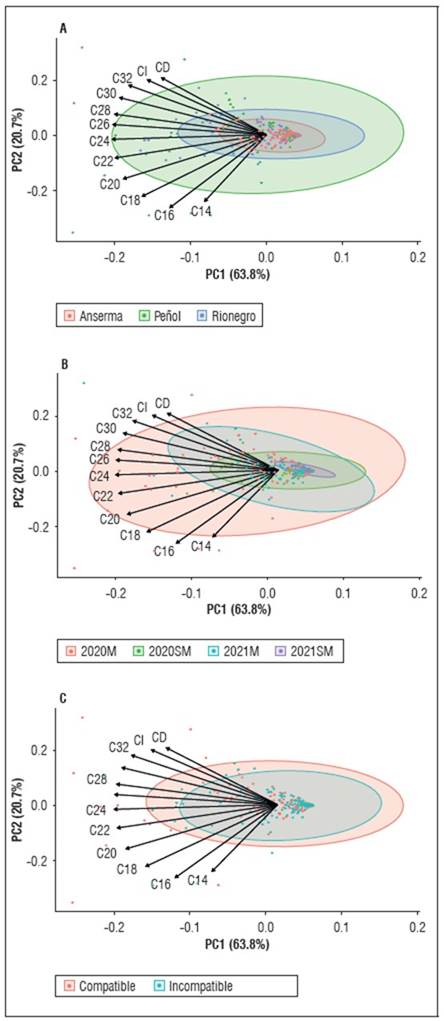
Figure 3. Biplot representation of the principal component analysis for the percentage distribution of fruit yield (kg) by caliber as a function of the locations (A), harvest seasons (B), and compatibility treatments (C). Main harvest (M). Secondary harvest 'Mitaca' (SM). The average values correspond to four harvests during two years (2020-2021).
Yield and yield components
Figure 4 shows the fruit number per avocado tree cv. Hass for compatibility (Fig. 4A) and harvest season (Fig. 4B) factors. Compatibility treatment did not significantly affect these variables in the four harvest seasons. Similar results were reported by King et al. (2010), who found that melon (Cucumis melo L.) plants with incompatibility symptoms did not present significant differences in fruit number, weight, and growth during the development period. Variation in yield efficiency and yield may be because of modifications in tree morphology and physiology of rootstocks, which was witnessed by scion-rootstock compatibility (Dubey et al., 2021). In particular, the effect of rootstock-scion interactions on reproductive potential, fruit set, yield efficiency, and avocado fruit quality characteristics are complex and poorly understood (Cano-Gallego et al., 2023). Likewise, Traka-Mavrona et al. (2000), when evaluating grafts of melon on rootstocks of pumpkin (Cucurbita spp.) with incompatibility symptoms (differences between the rootstock/scion stem diameter), did not find significant differences for the average fruit number. On the contrary, Shivran et al. (2023) stated that the scion/rootstock relation significantly influenced the number of fruits, yield, and yield efficiency of mango cultivars. On the other hand, the harvest season presented significant differences for the variable number of fruits per tree. The 2020M harvest showed the highest number of fruits (321 fruits/tree), significantly different from the 2021SM harvest (52 fruits/tree). Meanwhile, the harvests 2021M (166 fruits/tree) and 2020SM (143 fruits/tree) did not show significant differences.
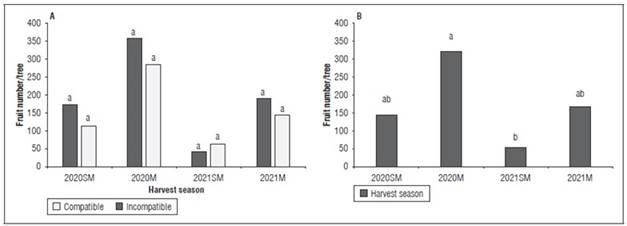
Figure 4. Number of fruits per avocado tree cv. Hass for compatibility (A) and harvest (B) factors. *Bars with common lowercase letters do not differ significantly at 5%, according to the least significant difference test through Holm's correction. **Main harvest season (M). Secondary harvest season 'Mitaca' (SM).
Regarding the fruit yield (kg/tree) of avocado cv. Hass, a behavior similar to the fruit number per tree was observed. The compatibility within harvest seasons (Fig. 5A) did not significantly affect the fruit weight produced, similar to what was found by Reig et al. (2018) and Reig et al. (2019), who, when evaluating apricot (Prunus armeniaca L.) and plum (Prunus domestica L.) trees with morphological differences between the diameters of the rootstock and the scion, found no significant differences for fruit yield; however, it was evidenced that the trees with symptoms of incompatibility presented deterioration of the stem structures, causing ruptures (in the scar) and overturning of the graft, due to tissue overgrowth (scion). Oka et al. (2004) evaluated the compatibility between the rootstock and the graft in paprika (Capsicum annuum L.), which showed a more significant number of fruits on the compatible plant (75 kg/plant) compared to incompatible plants (72.3 kg/tree), which presented interruptions in tissue continuity, affecting the movement of photoassimilates. Regarding the harvest period (Fig. 5B), in the 2020M season, the highest yields were presented (48.1 kg/tree). At the same time, 2021SM registered the lowest fruit yield (7.3 kg/tree), both distant statistically from the harvests 2020M (22.2 kg/tree) and 2021M (24.7 kg/tree), which did not differ statistically from each other.
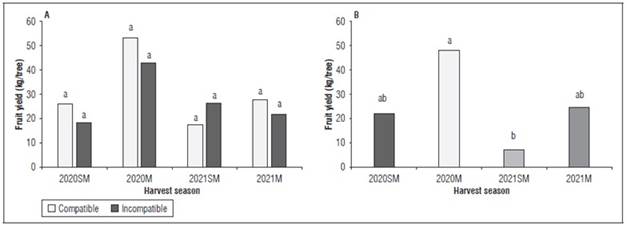
Figure 5. Total yield (kg/tree) in avocado trees cv. Hass for compatibility (A) and harvest (B) factors. *Bars with common lowercase letters do not differ significantly at 5%, according to the least significant difference test through Holm's correction. ** Main harvest season (M). Secondary harvest season 'Mitaca' (SM).
Notably, the main harvests (2020M and 2021M) contributed with 71.4% of the fruit number per tree and the total yield per tree (Fig. 4B and 5B), while the remaining 28.6% were harvested in the 'Mitaca' seasons. This variation is attributed to the weather of the producing regions under study, which affects the physiological and productive response of the avocado (Ramírez-Gil et al., 2019). Avocado is an alternating species that presents variations in flowering intensity between one year and the next one; it is characterized by offering a change that involves a high harvest load year (“on” year) and a low harvest load (“off” year) in the following year (Garner and Lovatt, 2016; Rebolledo and Romero, 2011). This behavior in tropical conditions, according to the availability of water and the occurrence of drier seasons, results in two harvests during the year: the main harvest (December-January) and the secondary harvest (June-July), also called 'Mitaca' or 'Naughty'. Thus, the main harvest is considered an “on” year (intense flowering, high fruit set percentage, and high yield). Meanwhile the secondary harvest 'Mitaca' is an “off” year (low flowering, low fruit set percentage, and low yield) (Dixon et al., 2007).
Lobell et al. (2007) reported rainfall above 151 mm month-1 favors avocado yield. In this sense, the regions where the present work was developed registered 190.5 mm of rainfall in March 2020 (main flowering stage) (Fig. 1), a good water supply that could favor the yield obtained in 2020P. In addition to the accumulated rainfall, the temperature plays an important role. During the 2020M harvest, where average (18.2°C) and minimum (14.4°C) temperatures were reported in the localities from February to December 2020. Higher to the harvest periods 2020SM, 2021SM, and 2021M (Fig. 1). Similar results were reported by Ramírez-Gil et al. (2019), who showed that higher temperatures during the post-anthesis of the fruits favor the development and, therefore, the yield of avocado cv. Hass. The minimum temperature plays a differential role in the flowering of avocado cv. Hass. Pattemore et al. (2018) state that temperatures between 13°C and 15°C favor the opening of female flowers during the early hours of the afternoon (13 to 15 h), favoring the pollination of some insects such as Apis mellifera. Temperatures below 13°C delay the flower opening period, starting in the early hours of the night, reducing pollination and decreasing fruit setting. Therefore, the minimum temperatures reported for 2020SM (March 2019), 2021SM (September 2020), and 2021M (March 2021) presented respective values of 12.9°C, 14.3°C, and 13.4°. In this way, the low temperatures could hinder pollination and, therefore, the production of the fruits in these periods, while for the flowering period of the 2020M harvest, the minimum temperature presented was 14.4°C, higher and in the ranges than reported for an early flowering opening in the afternoon. The temperature required for flowering and beginning fruit development (post-anthesis) of avocado cv. Hass was reported by Wolstenholme (2013), who indicated that the optimal temperature in which these phenological states are favored is between 19°C and 21.5°C, increasing fruit set and the amount of flower produced during the periods of anthesis. It is also mentioned that cultivars of the Guatemalan race and their hybrids are affected by average temperatures below 16°C, which, according to the temperature during the four harvest seasons, was not a limitation since the average temperature reached during the two years of evaluation it was kept at 17°C.
Regarding the percentage of avocado fruits by size (Tab. 2), there were no significant differences due to the compatibility factor or the C x Hs interaction. However, the harvest factor significantly affected most of the percentage proportions of each caliber in the avocado fruit. Despite the effect of the harvest season, a homogeneous behavior was not observed in the variation of this variable.
Table 2. Percentage proportions of each caliber in the compatible and incompatible avocado trees cv. Hass during four harvests (2020SM, 2020M, 2021SM, and 2021M).
| Factor | C14 | C16 | C18 | C20 | C22 | C24 |
|---|---|---|---|---|---|---|
| Harvest/p value * | 0.794 | 0.034 | 0.01 | 0.005 | 0.003 | 0.035 |
| 2020SM** | 0.34 a | 2.68 a | 9.10 a | 10.66 a | 16.27 a | 10.19 a |
| 2020M | 0.47 a | 1.92 ab | 7.26 a | 8.17 ab | 11.92 b | 8.40 ab |
| 2021SM | 0.30 a | 0.68 b | 2.51 b | 6.80 bc | 7.44 c | 7.69 b |
| 2021M | 0.39 a | 1.51 ab | 6.27 a | 2.97 c | 11.45 b | 7.16 b |
| Compatibility/p value * | 0.954 | 0.683 | 0.483 | 0.822 | 0.785 | 0.679 |
| Compatible | 0.38 a | 1.61 a | 5.84 a | 7.00 a | 11.95 a | 8.50 a |
| Incompatible | 0.37 a | 1.79 a | 6.74 a | 7.30 a | 11.58 a | 8.22 a |
| Compatibility * Harvest/p value * | 0.939 | 0.986 | 0.852 | 0.773 | 0.634 | 0.768 |
| Factor | C26 | C28 | C30 | C32 | DC | IC |
| Harvest/p value * | 0.23 | 0.028 | 0.033 | 0.001 | 0.053 | 0.013 |
| 2020SM** | 9.18 a | 9.41 ab | 10.64 b | 16.18 c | 2.80 b | 2.54 b |
| 2020M | 7.50 a | 7.76 b | 9.79 b | 22.95 bc | 8.24 a | 5.63 a |
| 2021SM | 7.52 a | 9.03 ab | 14.84 a | 34.76 a | 5.85 ab | 5.28 a |
| 2021M | 7.97 a | 10.68 a | 11.46 ab | 24.95 b | 7.02 a | 5.46 a |
| Compatibility/p value * | 0.991 | 0.953 | 0.96 | 0.869 | 0.905 | 0.933 |
| Compatible | 8.05 a | 9.24 a | 11.72 a | 24.90 a | 6.06 a | 4.76 a |
| Incompatible | 8.04 a | 9.20 a | 11.65 a | 24.52 a | 5.90 a | 4.70 a |
| Compatibility * Harvest/ p value * | 0.352 | 0.446 | 0.238 | 0.47 | 0.861 | 0.616 |
* Significance codes: 0 ‘***’ 0.001 ‘**’ 0.01 ‘*’ 0.05 ‘.’ 0.1 ‘ ’ 1. Caliber (C). Discard caliber (DC). Industrial caliber (IC). *Main harvest season (M). Secondary harvest season 'Mitaca' (SM). *** Treatments with a common letter do not differ significantly at 5%, according to the least significant difference test through Holm's correction.
Table 3 shows the percentage distribution of fruit yield (kg) by caliber, which compatibility and the C x Co interaction did not significantly affect. However, the harvest period significantly affected the percentage distribution of yield fruit (kg) for some sizes without observing a homogeneous behavior of the variations in the different fruit sizes. Calibers C24 to C32 presented the highest percentage contributions to fruit yield (kg). In contrast, C14 to C22 showed the lowest percentage contributions during the year 2021, compared to 2020 harvests, which presented an inverse behavior for the percentage variable of fruit yield per caliber.
Table 3. Percentage distribution of fruit yield (kg) by caliber (kg/tree) in avocado trees cv. Hass compatible and incompatible during four harvests (2020SM, 2020M, 2021SM, and 2021M).
| Factor | C14 | C16 | C18 | C20 | C22 | C24 |
|---|---|---|---|---|---|---|
| Harvest/p value * | 0.484 | 0.228 | 0.05 | 0.024 | 0.03 | 0.514 |
| 2020SM** | 0.35 a | 2.14 a | 8.42 ab | 10.30 a | 16.16 a | 10.13 a |
| 2020M | 0.93 a | 3.23 a | 10.67 a | 10.81 a | 14.61 a | 9.52 a |
| 2021SM | 0.66 a | 1.25 a | 4.03 b | 4.34 b | 9.98 b | 8.93 a |
| 2021M | 0.78 a | 2.67 a | 9.47 a | 9.25 a | 14.22 a | 8.88 a |
| Compatibility/p value * | 0.951 | 0.529 | 0.231 | 0.826 | 0.705 | 0.697 |
| Compatible | 0.69 a | 2.11 a | 7.15 a | 8.52 a | 14.00 a | 9.50 a |
| Incompatible | 0.67 a | 2.54 a | 9.15 a | 8.84 a | 13.49 a | 9.24 a |
| Compatibility * Harvest/ p value * | 0.893 | 0.847 | 0.920 | 0.909 | 0.844 | 0.493 |
| Factor | C26 | C28 | C30 | C32 | DC | IC |
| Harvest/p value * | 0.619 | 0.025 | 0.064 | 0.038 | 0.135 | 0.112 |
| 2020SM** | 9.34 a | 9.71 ab | 15.11 a | 17.83 b | 1.58 a | 2.06 a |
| 2020M | 8.11 a | 7.89 b | 9.27 a | 17.96 b | 3.66 a | 3.35 a |
| 2021SM | 8.86 a | 11.83 a | 11.98 a | 28.96 a | 2.77 a | 3.29 a |
| 2021M | 8.64 a | 9.21 b | 10.82 a | 19.61 b | 3.15 a | 3.30 a |
| Compatibility/p value * | 0.747 | 0.719 | 0.626 | 0.87 | 0.858 | 0.767 |
| Compatible | 8.85 a | 9.81 a | 12.15 a | 21.32 a | 2.85 a | 3.09 a |
| Incompatible | 8.63 a | 9.51 a | 11.44 a | 20.86 a | 2.74 a | 2.92 a |
| Compatibility * Harvest/ p value * | 0.430 | 0.548 | 0.605 | 0.875 | 0.965 | 0.669 |
* Significance codes: 0 ‘***’ 0.001 ‘**’ 0.01 ‘*’ 0.05 ‘.’ 0.1 ‘ ’ 1. Caliber (C). Discard caliber (DC). Industrial caliber (IC). *Main harvest season (M). Secondary harvest season 'Mitaca' (SM). *** Treatments with a common letter do not differ significantly at 5%, according to the least significant difference test through Holm's correction.
Authors such as Adhikari et al. (2022) and Pereira et al. (2014) indicate that rootstock/scion incompatibility is broadly categorized as ‘Translocated’ and ‘Localized’. ‘Translocated’ incompatibility is commonly evidenced in the first stages of plant development, associated with starch accumulation above the union and its absence below, phloem degeneration, normal vascular continuity at the union, overgrowth of the scion might be present, and early effects on growth (Tedesco et al., 2022). ‘Localized’ incompatibility is characterized, gradual starvation of the roots with slow development of external symptoms, and the immediate or delayed break of the union, produces plant malformations in graft scare between the rootstock and scion, which are caused by breaks in cambial vascular continuity which causes mechanical weakness to the union, little lignification, which leads to morphological changes in wood growth of these two plant tissues (Gainza et al., 2015; Tedesco et al., 2022). According to these incompatibility classes, the results of this study suggest that the anatomical changes evidenced in avocado trees with incompatibility symptoms may be associated with a localized incompatibility. However, anatomical wood tissue evaluations around graft scare should be carried out to evaluate these symptoms more accurately. This morphological incompatibility occurs because in Colombia, Creole rootstocks are generally obtained from the seed of selected "plus" "Creole" trees, originating rootstocks from interracial seedlings of open-pollinated half-siblings (Cañas-Gutiérrez et al., 2015; Cañas-Gutiérrez et al., 2022). Similarly, the majority of fruit nurseries use grafted avocado propagation using seedling rootstocks from a mixed seed source, however, the type of rootstock used influenced scion development and growth, rootstock inheritance had a significant impact on Hass avocado fruit load. Even if scion and rootstock are compatible, obtaining a sufficient number of compatible grafted seedlings from different scion-rootstock combinations remains difficult (Seid et al., 2023).
In addition to the results found in the present study, where incompatibility, in general, did not significantly affect fruit yield and quality avocado fruit; avocado fruits and leaves mineral nutrient content reported by Tamayo-Vélez et al. (2022), as well as leaf gas exchange variables (A, gs, E, Tl, and WUEi) (Cano-Gallego et al., 2023) and fruit respiratory rate nor the variables of growth and development of cv. Hass were not significantly affected by rootstock/scion compatibility symptoms (Cano-Gallego et al., 2024) too. Those authors indicated that peel (exocarp), pulp (mesocarp), seed coat (endocarp) and seed nutrients content were not affected by morphological incompatibility in avocado trees cv. Hass compared to trees defined as compatible, and that the morphological disparity between the rootstock/scion size of the stem did not significantly affect the avocado plants’ photosynthetic performance.
CONCLUSION
The avocado rootstock/scion incompatibility can be considered a located incompatibility with morphological alterations between tissues, which did not affect fruit number and yield per tree. However, harvest season influenced these variables, modified by the prevailing climatic conditions in each productive period. Fruit caliber did not present differential percentage behavior related to compatibility treatments, locations, and harvest seasons.
Conflict of interests: The manuscript was prepared and reviewed with the participation of the authors, who declare that there exists no conflict of interest that puts at risk the validity of the presented results.














